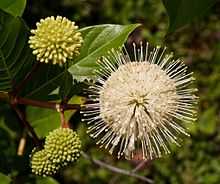Cephalanthus occidentalis
| Cephalanthus occidentalis | |
|---|---|
 | |
| C. o. var. occidentalis | |
| Scientific classification | |
| Kingdom: | Plantae |
| (unranked): | Angiosperms |
| (unranked): | Eudicots |
| (unranked): | Asterids |
| Order: | Gentianales |
| Family: | Rubiaceae |
| Genus: | Cephalanthus |
| Species: | C. occidentalis |
| Binomial name | |
| Cephalanthus occidentalis L., 1753[1] | |
| Varieties | |
|
C. o. var. californicus | |
 | |
| Natural range of Cephalanthus occidentalis | |
Cephalanthus occidentalis is a species of flowering plant in the coffee family, Rubiaceae, that is native to eastern and southern North America. Common names include Buttonbush, Common Buttonbush, Button-willow and Honey-bells.
Description
C. occidentalis is a deciduous shrub or small tree that averages 1–3 m (3.3–9.8 ft) in height, but can reach 6 m (20 ft). The leaves are opposite or in whorls of three, elliptic to ovate, 7–18 cm (2.8–7.1 in) long and 4–10 cm (1.6–3.9 in) broad, with a smooth edge and a short petiole. The flowers are arranged in a dense spherical inflorescence 2–3.5 cm (0.79–1.38 in) in diameter on a short peduncle. Each flower has a fused white to pale yellow four-lobed corolla forming a long slender tube connecting to the sepals. The stigma protrudes slightly from the corolla. The fruit is a spherical cluster of achenes (nutlets).[2]
Taxonomy
There are two varieties, not considered distinct by all authorities:
- Cephalanthus occidentalis var. occidentalis (syn. var. pubescens) – Common Buttonbush. Eastern North America from Nova Scotia west to Minnesota and south to Florida and eastern Texas.
- Cephalanthus occidentalis var. californicus – California Button-willow. Southwestern North America, from western Texas west to California (Sierra Nevada foothills, San Joaquin Valley, Sacramento Valley, and the Inner North Coast Ranges) and south to Mexico and Central America.
Habitat
Buttonbush is a common shrub of many wetland habitats in its range, including swamps, floodplains, mangrove, pocosin, riparian zones, and moist forest understory.[3] It is a member of the flora in the Everglades.[3]
Ecology
Waterfowl and other birds eat the seeds. Wood Ducks utilize the plant as nest protection. Deer browse the foliage. Insects and hummingbirds take the nectar, with bees using it to make honey.[3][4]
Distribution
The species occurs in eastern North America with disjunct populations occurring in the west. In Canada, it occurs from southern Ontario and Quebec east to New Brunswick. Besides the eastern United States, and eastern regions of the Midwest, notable areas range into Arizona, the Mogollon Rim, and other mountain ranges; in California, the entire San Joaquin Valley[5] West of the Great Plains and the Rocky Mountains, only western Texas, Arizona, and California find C. occidentalis.
Uses
Medicinal
C. occidentalis has a number of historical medicinal uses, but it is also toxic due to the presence of cephalathin.[4][3]
Cultivation
Buttonbush is cultivated as an ornamental plant for a nectar source or 'honey plant' and for aesthetics in gardens and native plant landscapes, and is planted on slopes to help control erosion.[6] Buttonbush is a suitable shrub for butterfly gardens.
San Joaquin Valley landmark tree
The town of Buttonwillow, California was named for the Buttonbush (Cephalanthus occidentalis). A lone buttonbush served as a landmark on an old trans-San Joaquin Valley trail, and was used by ancient Yokut Indians as a meeting place. It later became the site of settlers' stock rodeos. This buttonbush tree is listed as California Historical Landmark No. 492, and is now known as the "Buttonwillow Tree."
References
- ↑ "Cephalanthus occidentalis L.". Germplasm Resources Information Network. United States Department of Agriculture. 1994-08-23. Retrieved 2010-01-04.
- ↑ "Cephalanthus occidentalis L. buttonbush" (PDF). Wildland Shrubs of the United States and its Territories: Thamnic Descriptions. United States Forest Service. Retrieved 2009-09-14.
- ↑ 3.0 3.1 3.2 3.3 "Cephalanthus occidentalis". Fire Effects Information System. United States Forest Service.
- ↑ 4.0 4.1 "Common Buttonbush Cephalanthus occidentalis L." (PDF). Natural Resources Conservation Service Plant Guide. United States Department of Agriculture.
- ↑ Little. Atlas of United States Trees, Volume 3, Minor Western Hardwoods, Little, Elbert L, 1976, US Government Printing Office. Library of Congress No. 79-653298. Map 34-NW, Map 34-SW, Cephalanthus occidentalis.
- ↑ O'Sullivan, Penelope (2007). The Homeowner's Complete Tree & Shrub Handbook: The Essential Guide to Choosing, Planting, and Maintaining Perfect Landscape Plants. Storey Publishing. p. 197. ISBN 978-1-58017-571-5.
External links
![]() Data related to Cephalanthus occidentalis at Wikispecies
Data related to Cephalanthus occidentalis at Wikispecies
![]() Media related to Cephalanthus occidentalis at Wikimedia Commons
Media related to Cephalanthus occidentalis at Wikimedia Commons
- "Cephalanthus occidentalis" (PDF). Digital Representations of Tree Species Range Maps from "Atlas of United States Trees" by Elbert L. Little, Jr. (and other publications). United States Geological Survey.
- USDA Plants Profile: Cephalanthus occidentalis
- Missouriplants: Cephalanthus occidentalis var. occidentalis
- Jepson Flora Project: Cephalanthus occidentalis var. californicus
- Photo gallery